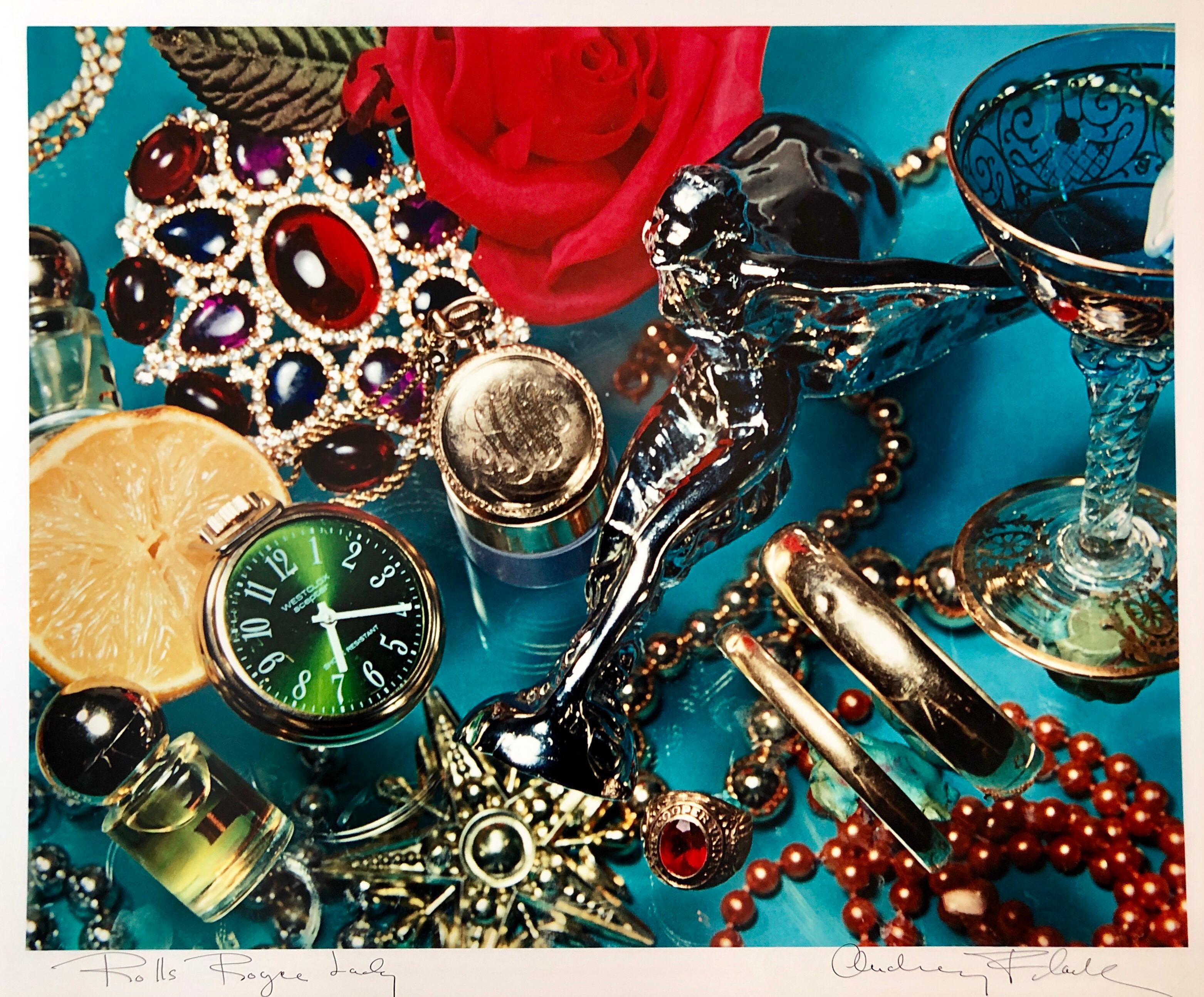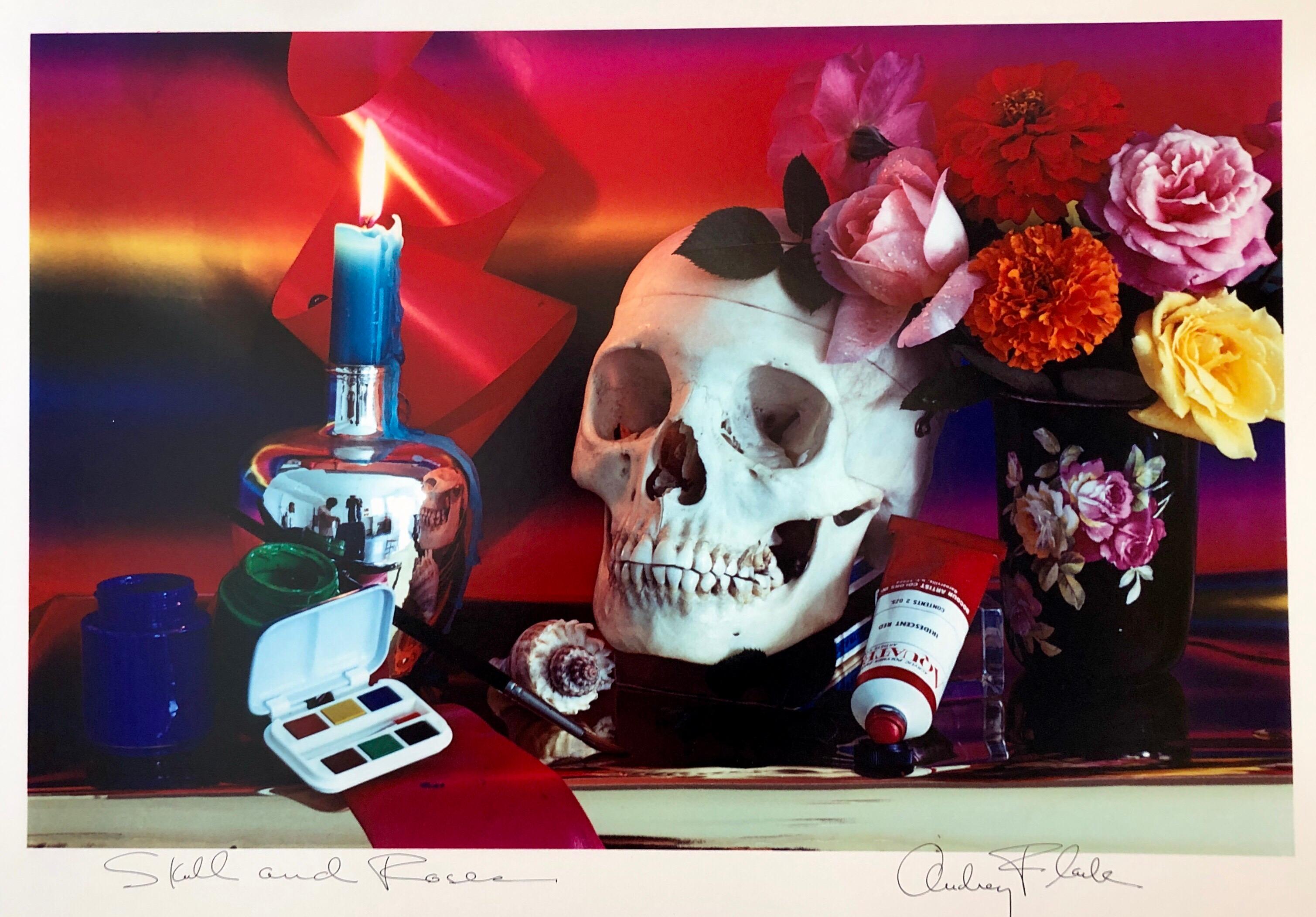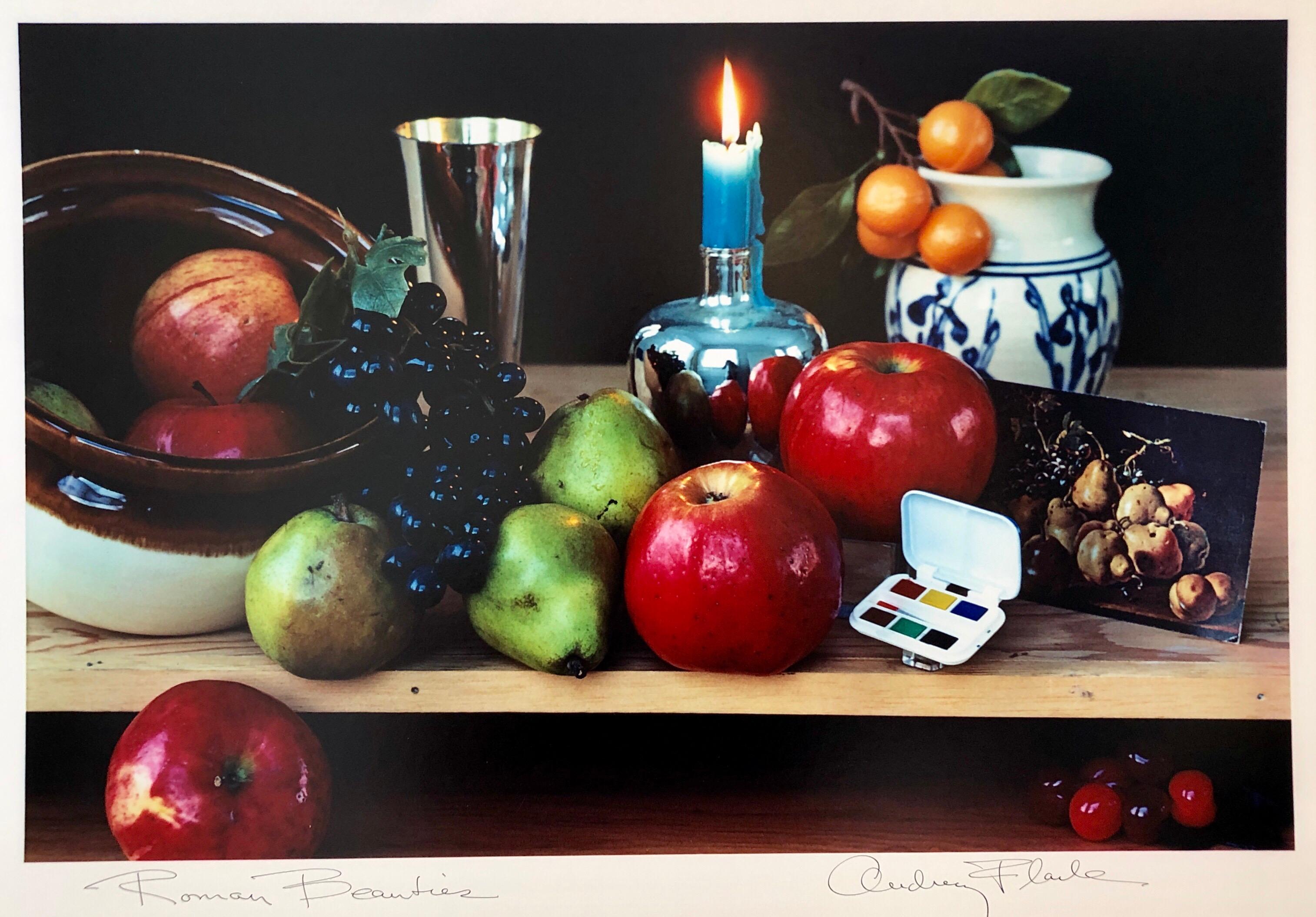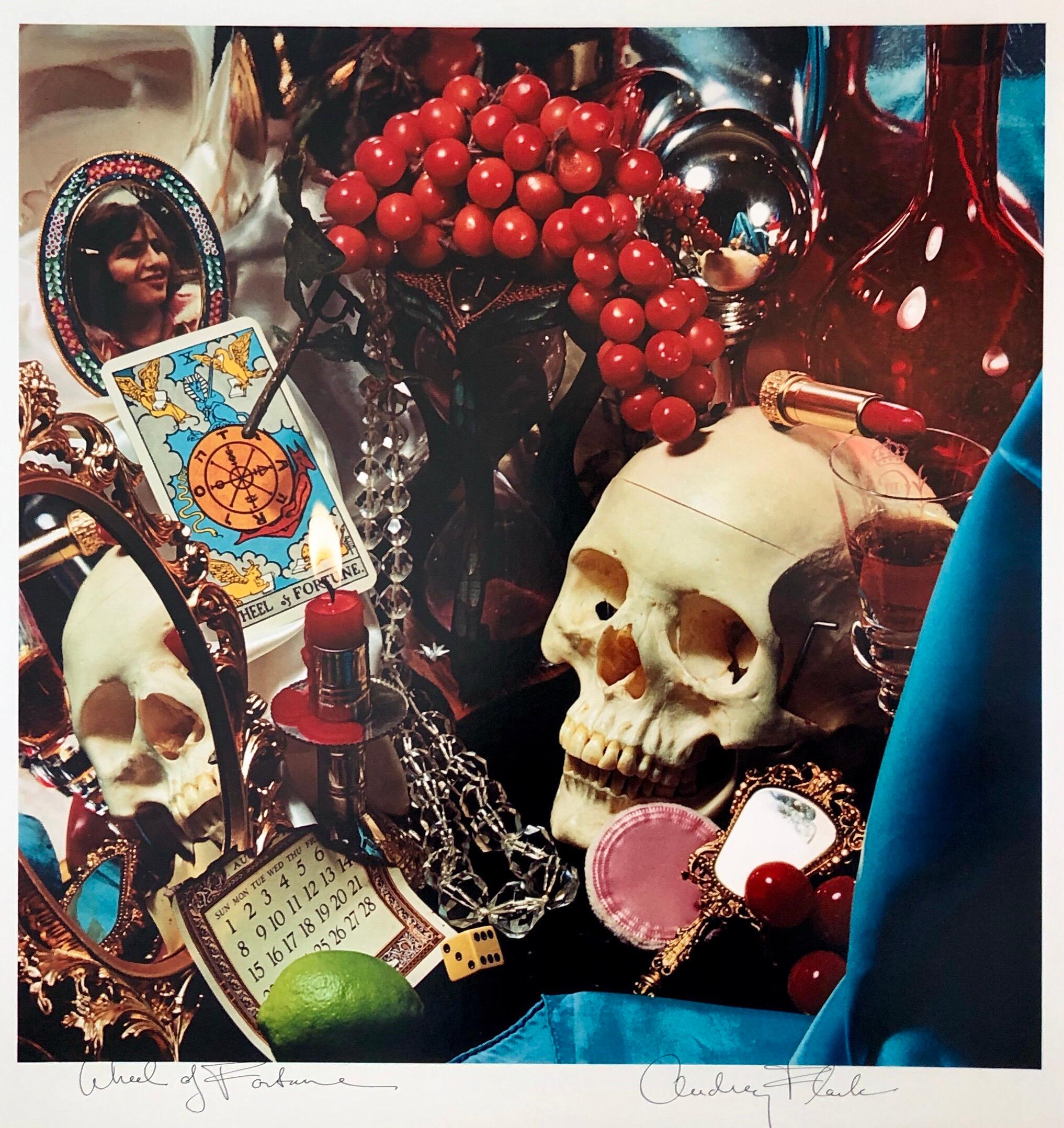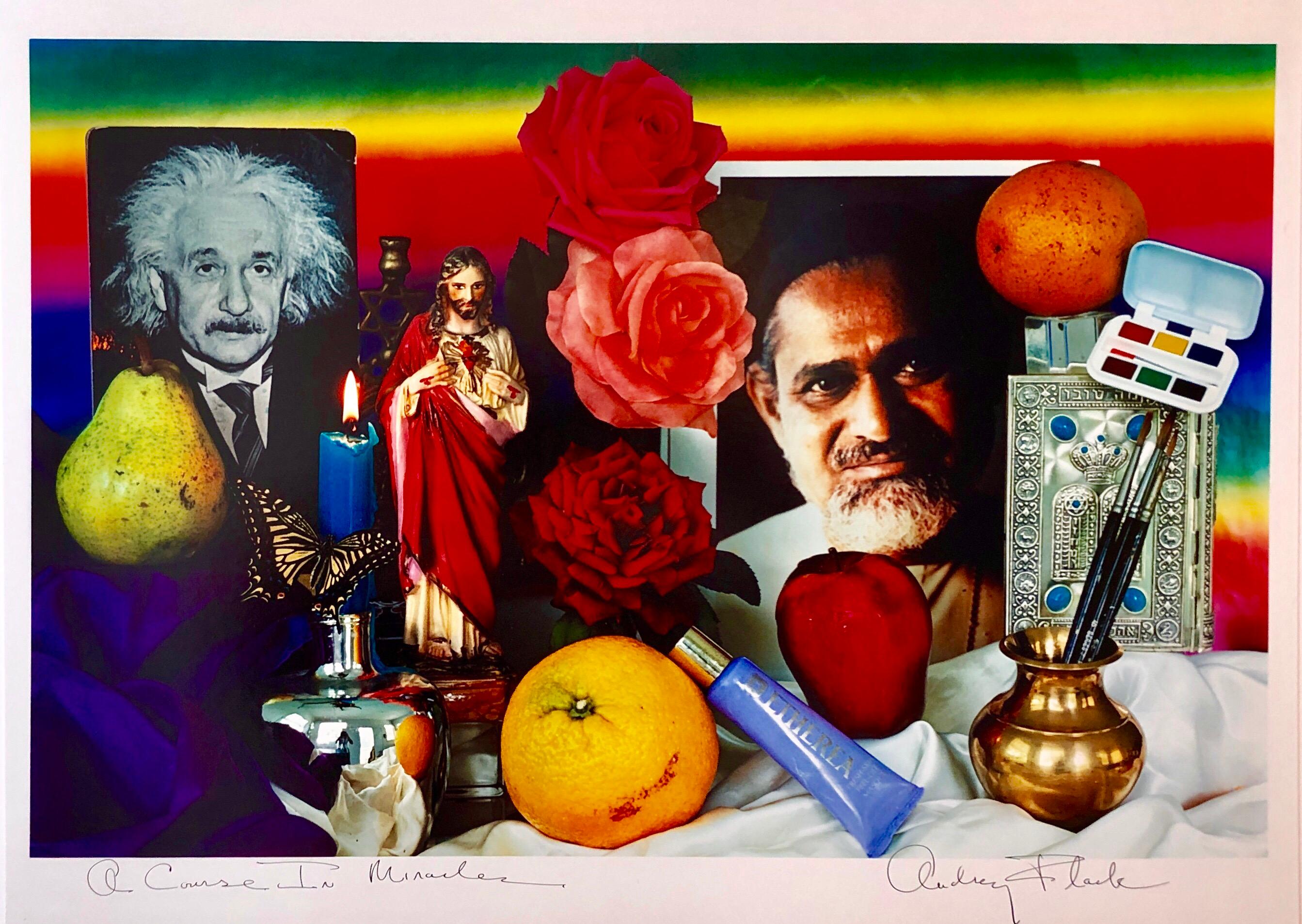Items Similar to Pop Art Vintage Color Photograph Dye Transfer Print Audrey Flack Judaica Photo
Want more images or videos?
Request additional images or videos from the seller
1 of 14
Audrey FlackPop Art Vintage Color Photograph Dye Transfer Print Audrey Flack Judaica Photo1984
1984
About the Item
Hand signed and titled in ink by the artist from edition of 50 (plus proofs). Color Photo printed at CVI Lab by master printer Guy Stricherz. Published by Prestige Art Ltd. From the color saturated 1980's. "World War II" featuring Holocaust concentration camp survivors in prison uniforms, pears, flowers, a lit candle, a red rose, petit fours, a butterfly, and a locket with a Jewish star of David.
Audrey L. Flack (born May 30, 1931 in New York City, New York) is an American artist. Her work pioneered the art genre of photorealism; her work encompasses painting, sculpture, and photography. From Audrey Flack: 12 Photographs 1973 to 1983. A set of this portfolio is in the collections of the Harvard Art Museums. The Kodakchrome photos were photgraphed with a NIkon camera, the Ektachrome photographs were taken with a Hasselblad camera. Each negative was printed on a 20 X24 inche fiber based paper, dry mounted wth seal MT5 dry mounting tissue to 4 ply 100% cotton fiber board by Arnon Ben-David and Ari Rivera Gonzales under the supervision of Carol Brower.
Flack has numerous academic degrees, including both a graduate and an honorary doctorate degree from Cooper Union in New York City. Additionally she has a bachelor's degree in Fine Arts from Yale University and attended New York University Institute of Fine Arts where she studied art history. In May 2015, Flack received an honorary Doctor of Fine Arts degree from Clark University, where she also gave a commencement address.
Flack's work is displayed in several major museums, including the Museum of Modern Art, the Metropolitan Museum of Art, the Whitney Museum of American Art, and the Solomon R. Guggenheim Museum. Flack's photorealist paintings were the first such paintings to be purchased for the Museum of Modern Art’s permanent collection, and her legacy as a photorealist lives on to influence many American and International artists today. J. B. Speed Art Museum in Louisville, Kentucky, organized a retrospective of her work, and Flack’s pioneering efforts into the world of photorealism popularized the genre to the extent that it remains today.
Flack attended New York's High School of Music & Art. She studied fine arts in New York from 1948 to 1953, studying under Josef Albers among others. She earned a graduate degree and received an honorary doctorate from Cooper Union in New York City, and a Bachelor of Fine Arts from Yale University. She studied art history at the Institute of Fine Arts, New York University.
1953 New York University Institute of Fine Arts, New York City
1952 BFA, Yale University, New Haven, Connecticut
1948-51 Cooper Union, New York City
Career
Flack's early work in the 1950s was abstract expressionist; one such painting paid tribute to Franz Kline. Most influential amongst her early supporters was the Bauhaus artist Josef Albers. It was he who persuaded Flack to take up a scholarship at Yale with the mission of shaking up the institution's stuffy academic reputation. The ironic kitsch themes in her early work influenced Jeff Koons. But gradually, Flack became a New Realist and then evolved into photorealism during the 1960s. Her move to the photorealist style was in part because she wanted her art to communicate to the viewer. She was the first photorealist painter to be added to the collection of the Museum of Modern Art in 1966. Between 1976 and 1978 she painted her Vanitas series, including the piece Marilyn.
The critic Graham Thompson wrote, "One demonstration of the way photography became assimilated into the art world is the success of photorealist painting in the late 1960s and early 1970s. It is also called super-realism, radical realism, or hyper-realism and painters like Richard Estes, Chuck Close, and Audrey Flack as well, often worked from photographic stills to create paintings that appeared to be photographs."
In the early 1980s Flack's artistic medium shifted from painting to sculpture. She describes this shift as a desire for "something solid, real, tangible. Something to hold and to hold on to." Flack discusses the fact that she is self-taught in sculpture. She incorporates religion and mythology into her sculpture rather than the historical or everyday subjects of her paintings. Her sculptures often demonstrate a connection to the female form, including a series of diverse, heroic women and goddess figures. These depictions of women differ from those of traditional femininity, but rather are athletic, older, and strong. As Flack describes them: "they are real yet idealized... the 'goddesses in everywoman.'"
Flack has claimed to have found the photorealist movement too restricting, and now gains much of her inspiration from Baroque art.
Flack is currently represented by the Louis K. Meisel Gallery and Hollis Taggart Galleries. Her work is held in the collections of museums around the world, including the Metropolitan Museum of Art, The Museum of Modern Art, the Solomon R. Guggenheim Museum, the Whitney Museum of American Art, the Allen Memorial Art Museum, and the National Gallery of Australia in Canberra, Australia.
She was awarded the St. Gaudens Medal from Cooper Union, and the honorary Albert Dome professorship from Bridgeport University. She is an honorary professor at George Washington University, is currently a visiting professor at the University of Pennsylvania and has taught and lectured extensively both nationally, and internationally.
Flack lives and works in New York City and Long Island.
Audrey Flack is best known for her photo-realist paintings and was one of the first artists to use photographs as the basis for painting. The genre, taking its cues from Pop Art, incorporates depictions of the real and the regular, from advertisements to cars to cosmetics. Flack's work brings in everyday household items like tubes of lipstick, perfume bottles, Hispanic Madonnas, and fruit. These inanimate objects often disturb or crowd the pictorial space, which are often composed as table-top still lives. Flack often brings in actual accounts of history into her photorealist paintings, such as World War II' (Vanitas) and Kennedy Motorcade. Women were frequently the subject of her photo realist paintings. In her Neoclassical public sculpture of gilded bronze angels, muses, and goddesses, Flack mines Greek mythology, presenting the female in an array of archetypal guises. Though some critics have condemned her focus on the classical white female, Flack is an avowed feminist, and many of her sculptures seek to reinvent their subjects and source material. Along with Nancy Spero, Joan Snyder, Joyce Kozloff, Miriam Schapiro and Judy Chicago, she is from that first generation of Jewish American woman artists and includes Judaica in her work.
Select Solo exhibitions
2017 "Audrey Flack: Master Drawings from Crivelli," Hollis Taggart Galleries, New York, NY
2015-2016 "Heroines: Audrey Flack's Transcendent Drawings and Prints," Williams Center Galleries, Lafayette College, PA; The Hyde Collection Art Museum & Historic House, Glens Falls, NY; The Butler Institute of American Art, Youngstown, OH
2015 "Audrey Flack: The Abstract Expressionist Years," Hollis Taggart Galleries, New York, NY
2012 "Audrey Flack: Sculpture, 1989-2012," Garth Greenan Gallery, New York, NY
2010 "Audrey Flack Paints a Picture," Gary Snyder Gallery, New York, NY
2007 "Daphne Speaks: An Exhibition of Sculpture and Master Workshop Prints," University of North Dakota, Grand Forks, ND
2007 "Audrey Flack: Abstract Expressionist," Rider University Art Gallery, Lawrenceville, NJ
2007 "Plasters and Disasters - Audrey Flack's Recent Sculpture," Kingsborough Community College, NY
2002 "Drawings, Watercolors and Sculptures - Responses to 9/11," Vered Gallery, East Hampton, New York
2001 "Plein Air Watercolors and Drawings," Bernaducci-Meisel Gallery, New York, New York
1999 "Icons of the 20th Century," Savannah College of Art and Design, Savannah, Georgia
1998 "Audrey Flack - New Work," Louis K. Meisel Gallery, New York, New York
1996 "Daphne Speaks," Guild Hall Museum, East Hampton, New York
1996 "Amor Vincit Omnia," Art Museum of Western Virginia, Roanoke, Virginia
Select Public collections
Museum of Modern Art, New York, New York
Solomon R. Guggenheim Museum, New York, New York
Whitney Museum of American Art, New York, New York
Metropolitan Museum of Art, New York, New York
St. Louis Museum of Art, St. Louis, Missouri
Dallas Museum of Fine Art, Dallas, Texas
University of Arizona, Phoenix, Arizona
Albright-Knox Art Gallery, Buffalo, New York
Walker Art Center, Minneapolis, Minnesota
Mint Museum of Art, Charlotte, North Carolina
Rose Art Museum, Brandeis University, Waltham, Massachusetts
Allen Memorial Art Museum, Oberlin College, Oberlin, Ohio
Stuart M. Speiser Collection, Smithsonian Institution, Washington, DC
HHK Foundation for Contemporary Art, Inc., New York, New York
Australian National Gallery, Canberra, Australia
National Gallery of Victoria, Melbourne, Australia
San Francisco Museum of Fine Art, San Francisco, California
National Museum of American Art, Washington, DC
University of Texas at Austin, Austin, Texas
Wadsworth Athenaeum, Hartford, Connecticut
Capricorn Gallery, Baltimore, Maryland
Akron Art Museum, Akron, Ohio
National Museum of Women in the Arts, Washington, DC
New York University Collections, New York, New York
Reynolda House Museum, Winston-Salem, North Carolina
Art Museum of Western Virginia, Roanoke, Virginia
Speed Museum of Art, Louisville, Kentucky
Cornell Fine Arts Museum, Winter Park, Florida
Butler Institute of American Art, Youngstown, Ohio
Hudson River Museum, Yonkers, New York
Cameron Art Museum, Wilmington North Carolina
The Tampa Museum of Art, Tampa Florida
East Hampton Center of Contemporary Art, East Hampton, New York
Minneapolis Institute of Art, Minneapolis, Minnesota
- Creator:Audrey Flack (1931, American)
- Creation Year:1984
- Dimensions:Height: 20 in (50.8 cm)Width: 24 in (60.96 cm)
- Medium:
- Movement & Style:
- Period:
- Condition:good, never framed.
- Gallery Location:Surfside, FL
- Reference Number:1stDibs: LU3824660742
About the Seller
4.9
Platinum Seller
These expertly vetted sellers are 1stDibs' most experienced sellers and are rated highest by our customers.
Established in 1995
1stDibs seller since 2014
1,546 sales on 1stDibs
Typical response time: 1 hour
- ShippingRetrieving quote...Ships From: Surfside, FL
- Return PolicyA return for this item may be initiated within 3 days of delivery.
More From This SellerView All
- Pop Art Color Photograph Dye Transfer Print Audrey Flack Rolls Royce Lady PhotoBy Audrey FlackLocated in Surfside, FLHand signed and titled in ink by the artist from edition of 50 (plus proofs). Color Photo printed at CVI Lab by master printer Guy Stricherz. Published by Prestige Art Ltd. From the color saturated 1980's. "Rolls Royce Lady" featuring a sculpture the Spirit of Ecstasy, a crystal goblet, dice, flowers, a pocket watch, jewelry, perfume and a red rose. Audrey L. Flack (born May 30, 1931 in New York City, New York) is an American artist. Her work pioneered the art genre of photorealism; her work encompasses painting, sculpture, and photography. From Audrey Flack: 12 Photographs 1973 to 1983. A set of this portfolio is in the collections of the Harvard Art Museums. The Kodakchrome photos were photgraphed with a NIkon camera, the Ektachrome photographs were taken with a Hasselblad camera. Each negative was printed on a 20 X24 inche fiber based paper, dry mounted wth seal MT5 dry mounting tissue to 4 ply 100% cotton fiber board by Arnon Ben-David and Ari Rivera Gonzales under the supervision of Carol Brower. Flack has numerous academic degrees, including both a graduate and an honorary doctorate degree from Cooper Union in New York City. Additionally she has a bachelor's degree in Fine Arts from Yale University and attended New York University Institute of Fine Arts where she studied art history. In May 2015, Flack received an honorary Doctor of Fine Arts degree from Clark University, where she also gave a commencement address. Flack's work is displayed in several major museums, including the Museum of Modern Art, the Metropolitan Museum of Art, the Whitney Museum of American Art, and the Solomon R. Guggenheim Museum. Flack's photorealist paintings were the first such paintings to be purchased for the Museum of Modern Art’s permanent collection, and her legacy as a photorealist lives on to influence many American and International artists today. J. B. Speed Art Museum in Louisville, Kentucky, organized a retrospective of her work, and Flack’s pioneering efforts into the world of photorealism popularized the genre to the extent that it remains today. Flack attended New York's High School of Music & Art. She studied fine arts in New York from 1948 to 1953, studying under Josef Albers among others. She earned a graduate degree and received an honorary doctorate from Cooper Union in New York City, and a Bachelor of Fine Arts from Yale University. She studied art history at the Institute of Fine Arts, New York University. 1953 New York University Institute of Fine Arts, New York City 1952 BFA, Yale University, New Haven, Connecticut 1948-51 Cooper Union, New York City Career Flack's early work in the 1950s was abstract expressionist; one such painting paid tribute to Franz Kline. Most influential amongst her early supporters was the Bauhaus artist Josef Albers. It was he who persuaded Flack to take up a scholarship at Yale with the mission of shaking up the institution's stuffy academic reputation. The ironic kitsch themes in her early work influenced Jeff Koons. But gradually, Flack became a New Realist and then evolved into photorealism during the 1960s. Her move to the photorealist style was in part because she wanted her art to communicate to the viewer. She was the first photorealist painter to be added to the collection of the Museum of Modern Art in 1966. Between 1976 and 1978 she painted her Vanitas series, including the piece Marilyn. The critic Graham Thompson wrote, "One demonstration of the way photography became assimilated into the art world is the success of photorealist painting in the late 1960s and early 1970s. It is also called super-realism, radical realism, or hyper-realism and painters like Richard Estes, Chuck Close, and Audrey Flack as well, often worked from photographic stills to create paintings that appeared to be photographs." In the early 1980s Flack's artistic medium shifted from painting to sculpture. She describes this shift as a desire for "something solid, real, tangible. Something to hold and to hold on to." Flack discusses the fact that she is self-taught in sculpture. She incorporates religion and mythology into her sculpture rather than the historical or everyday subjects of her paintings. Her sculptures often demonstrate a connection to the female form, including a series of diverse, heroic women and goddess figures. These depictions of women differ from those of traditional femininity, but rather are athletic, older, and strong. As Flack describes them: "they are real yet idealized... the 'goddesses in everywoman.'" Flack has claimed to have found the photorealist movement too restricting, and now gains much of her inspiration from Baroque art. Flack is currently represented by the Louis K. Meisel Gallery and Hollis Taggart Galleries. Her work is held in the collections of museums around the world, including the Metropolitan Museum of Art, The Museum of Modern Art, the Solomon R. Guggenheim Museum, the Whitney Museum of American Art, the Allen Memorial Art Museum, and the National Gallery of Australia in Canberra, Australia. She was awarded the St. Gaudens Medal from Cooper Union, and the honorary Albert Dome professorship from Bridgeport University. She is an honorary professor at George Washington University, is currently a visiting professor at the University of Pennsylvania and has taught and lectured extensively both nationally, and internationally. Flack lives and works in New York City and Long Island. Audrey Flack is best known for her photo-realist paintings and was one of the first artists to use photographs as the basis for painting. The genre, taking its cues from Pop Art, incorporates depictions of the real and the regular, from advertisements to cars to cosmetics. Flack's work brings in everyday household items like tubes of lipstick, perfume bottles, Hispanic Madonnas, and fruit. These inanimate objects often disturb or crowd the pictorial space, which are often composed as table-top still lives. Flack often brings in actual accounts of history into her photorealist paintings, such as World War II' (Vanitas) and Kennedy Motorcade. Women were frequently the subject of her photo realist paintings. In her Neoclassical public sculpture of gilded bronze angels...Category
1980s Photorealist Color Photography
MaterialsPhotographic Paper, C Print, Dye Transfer
- Pop Art Color Photograph Dye Transfer Print Audrey Flack "Skull & Roses" PhotoBy Audrey FlackLocated in Surfside, FLHand signed and titled in ink by the artist from edition of 50 (plus proofs). Color Photo printed at CVI Lab by master printer Guy Stricherz. Published by Prestige Art Ltd. From the ...Category
1980s Photorealist Color Photography
MaterialsDye Transfer, Photographic Paper, C Print
- Pop Art Vintage Color Photograph Dye Transfer Print Audrey Flack Fruits PhotoBy Audrey FlackLocated in Surfside, FLHand signed and titled in ink by the artist from edition of 50 (plus proofs). Color Photo printed at CVI Lab by master printer Guy Stricherz. Published by Prestige Art Ltd. From the ...Category
1980s Photorealist Color Photography
MaterialsPhotographic Paper, C Print, Dye Transfer
- Pop Art Color Photograph Dye Transfer Print Audrey Flack Tarot Card, Skull PhotoBy Audrey FlackLocated in Surfside, FLHand signed and titled in ink by the artist from edition of 50 (plus proofs). Color Photo printed at CVI Lab by master printer Guy Stricherz. Published by Prestige Art Ltd. From the color saturated 1980's. "Wheel of Fortune" featuring a tarot card, a skull, lipstick, a crystal necklace, candle, mirror etc. Audrey L. Flack (born May 30, 1931 in New York City, New York) is an American artist. Her work pioneered the art genre of photorealism; her work encompasses painting, sculpture, and photography. From Audrey Flack: 12 Photographs 1973 to 1983. A set of this portfolio is in the collections of the Harvard Art Museums. The Kodakchrome photos were photgraphed with a NIkon camera, the Ektachrome photographs were taken with a Hasselblad camera. Each negative was printed on a 20 X24 inche fiber based paper, dry mounted wth seal MT5 dry mounting tissue to 4 ply 100% cotton fiber board by Arnon Ben-David and Ari Rivera Gonzales under the supervision of Carol Brower. Flack has numerous academic degrees, including both a graduate and an honorary doctorate degree from Cooper Union in New York City. Additionally she has a bachelor's degree in Fine Arts from Yale University and attended New York University Institute of Fine Arts where she studied art history. In May 2015, Flack received an honorary Doctor of Fine Arts degree from Clark University, where she also gave a commencement address. Flack's work is displayed in several major museums, including the Museum of Modern Art, the Metropolitan Museum of Art, the Whitney Museum of American Art, and the Solomon R. Guggenheim Museum. Flack's photorealist paintings were the first such paintings to be purchased for the Museum of Modern Art’s permanent collection, and her legacy as a photorealist lives on to influence many American and International artists today. J. B. Speed Art Museum in Louisville, Kentucky, organized a retrospective of her work, and Flack’s pioneering efforts into the world of photorealism popularized the genre to the extent that it remains today. Flack attended New York's High School of Music & Art. She studied fine arts in New York from 1948 to 1953, studying under Josef Albers among others. She earned a graduate degree and received an honorary doctorate from Cooper Union in New York City, and a Bachelor of Fine Arts from Yale University. She studied art history at the Institute of Fine Arts, New York University. 1953 New York University Institute of Fine Arts, New York City 1952 BFA, Yale University, New Haven, Connecticut 1948-51 Cooper Union, New York City Career Flack's early work in the 1950s was abstract expressionist; one such painting paid tribute to Franz Kline. Most influential amongst her early supporters was the Bauhaus artist Josef Albers. It was he who persuaded Flack to take up a scholarship at Yale with the mission of shaking up the institution's stuffy academic reputation. The ironic kitsch themes in her early work influenced Jeff Koons. But gradually, Flack became a New Realist and then evolved into photorealism during the 1960s. Her move to the photorealist style was in part because she wanted her art to communicate to the viewer. She was the first photorealist painter to be added to the collection of the Museum of Modern Art in 1966. Between 1976 and 1978 she painted her Vanitas series, including the piece Marilyn. The critic Graham Thompson wrote, "One demonstration of the way photography became assimilated into the art world is the success of photorealist painting in the late 1960s and early 1970s. It is also called super-realism, radical realism, or hyper-realism and painters like Richard Estes, Chuck Close, and Audrey Flack as well, often worked from photographic stills to create paintings that appeared to be photographs." In the early 1980s Flack's artistic medium shifted from painting to sculpture. She describes this shift as a desire for "something solid, real, tangible. Something to hold and to hold on to." Flack discusses the fact that she is self-taught in sculpture. She incorporates religion and mythology into her sculpture rather than the historical or everyday subjects of her paintings. Her sculptures often demonstrate a connection to the female form, including a series of diverse, heroic women and goddess figures. These depictions of women differ from those of traditional femininity, but rather are athletic, older, and strong. As Flack describes them: "they are real yet idealized... the 'goddesses in everywoman.'" Flack has claimed to have found the photorealist movement too restricting, and now gains much of her inspiration from Baroque art. Flack is currently represented by the Louis K. Meisel Gallery and Hollis Taggart Galleries. Her work is held in the collections of museums around the world, including the Metropolitan Museum of Art, The Museum of Modern Art, the Solomon R. Guggenheim Museum, the Whitney Museum of American Art, the Allen Memorial Art Museum, and the National Gallery of Australia in Canberra, Australia. She was awarded the St. Gaudens Medal from Cooper Union, and the honorary Albert Dome professorship from Bridgeport University. She is an honorary professor at George Washington University, is currently a visiting professor at the University of Pennsylvania and has taught and lectured extensively both nationally, and internationally. Flack lives and works in New York City and Long Island. Audrey Flack is best known for her photo-realist paintings and was one of the first artists to use photographs as the basis for painting. The genre, taking its cues from Pop Art, incorporates depictions of the real and the regular, from advertisements to cars to cosmetics. Flack's work brings in everyday household items like tubes of lipstick, perfume bottles, Hispanic Madonnas, and fruit. These inanimate objects often disturb or crowd the pictorial space, which are often composed as table-top still lives. Flack often brings in actual accounts of history into her photorealist paintings, such as World War II' (Vanitas) and Kennedy Motorcade. Women were frequently the subject of her photo realist paintings. In her Neoclassical public sculpture of gilded bronze...Category
1980s Photorealist Color Photography
MaterialsPhotographic Paper, C Print, Dye Transfer
- Pop Art Vintage Color Photograph "Course in Miracles" Print Audrey Flack PhotoBy Audrey FlackLocated in Surfside, FLHand signed and titled in ink by the artist from edition of 50 (plus proofs). Color Photo printed at CVI Lab by master printer Guy Stricherz. Published by Prestige Art Ltd. From the color saturated 1980's. "A course in miracles"" The title, taken from the 1976 book on New Age spiritual guidance encourages speculation about each element in this still life. The amount of roses--three--is a significant number in many religions and mythologies. Besides Jesus and Albert Einstein, Flack included the silent mystic Hindu philanthropist Shree Krishnaji, also known as Baba. Flack used the detail of his face with the roses, hovering above the ocean, in her monumental painting, Baba. Following an illness, she turned to mysticism, framing Christian and Hindu images with Jewish ones in A Course of Miracles of 1983: On the “west” side, a photograph of Albert Einstein and a European Jewish candlestick...Category
1980s Photorealist Color Photography
MaterialsPhotographic Paper, C Print, Dye Transfer
- Pop Art Vintage Color Photograph Dye Transfer Print "Time to Save" Audrey FlackBy Audrey FlackLocated in Surfside, FLHand signed and titled in ink by the artist from edition of 50 (plus proofs). Color Photo printed at CVI Lab by master printer Guy Stricherz. Published by Prestige Art Ltd. From the ...Category
1980s Photorealist Color Photography
MaterialsPhotographic Paper, C Print, Dye Transfer
You May Also Like
- What Love is 6By MaleonnLocated in New York, NYThe son of a known Chinese drama director and a very famous actress, Maleonn grew up in an artistic environment, where he began to study art when only 11 years old. After graduating ...Category
2010s Photorealist Color Photography
MaterialsPlexiglass, Photographic Film, Mixed Media, Photographic Paper, Photogram
- Flora Odyssey No6, Allan Forsyth, Floral Photographic Print, Limited Edition ArtBy Allan ForsythLocated in Deddington, GBFLORA ODYSSEY N°6 by Allan Forsyth [2021] Limited edition Archival Chromagenic Photographic Print Edition of 12 Image size: H:100 cm x W:100 cm Complete Size of Unframed Work: H:100...Category
21st Century and Contemporary Photorealist Still-life Photography
MaterialsPhotographic Paper, Color
- Tyler Shields - Yellow Brick Road (Dye Transfer), 2019, Printed AfterBy Tyler ShieldsLocated in Greenwich, CTSeries: Fairytale Yellow Brick Road a 30 by 30 inch Dye Transfer, only 3 of these prints will ever be made no other sizes no other editions. These prints go for a higher price then ...Category
21st Century and Contemporary Contemporary Color Photography
MaterialsDye, Photographic Paper, Dye Transfer
- Sunflower StudyLocated in Norwalk, CTThis image is part of my Floraphilia portfolio that has been an ongoing visual exploration for over two decades. A B&W portfolio was first published in Lenswork Magazine in 2010, a s...Category
2010s Photorealist Still-life Photography
MaterialsDigital Pigment, Archival Paper, Archival Ink
- Arcangelo, Interior Photography, Contemporary Artwork, Light Art PhotographyBy Gina SodenLocated in Deddington, GB"An incredibly decorative villa from the 1700’s, which had been semi-restored to it’s former glory and is now awaiting it’s future. A very well known Italian composer was born nearby...Category
2010s Photorealist Color Photography
MaterialsDigital Pigment, Paper
- Submerge, Interior Photography, Derelict Building Artwork, Light Art PhotographyBy Gina SodenLocated in Deddington, GBSubmerge by Gina Soden [2020] Please note that insitu images are purely an indication of how a piece may look "I photographed this in an abandoned manor in the south of France. The ...Category
21st Century and Contemporary Photorealist Color Photography
MaterialsPaper, Digital Pigment
Recently Viewed
View AllMore Ways To Browse
Solid Color
Vintage Color Flowers
Sculpture In Black Color
Vintage Color Roses
Mint Color
Space Dye
Religion Art
Vintage Bronze Color
Mission Style Art
Vintage Star Photo
Vintage Pop Art
Vintage Flower Photo
Vintage Flowers Photo
Vintage Flowers Photos
Vintage Flower Photos
Vintage Camping Art
Vintage Bauhaus Art
Vintage Color Sculpture
